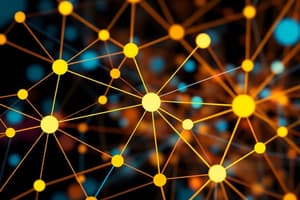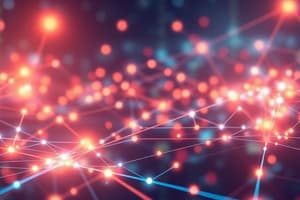Podcast
Questions and Answers
Which of the following is NOT a component of a data communication system?
Which of the following is NOT a component of a data communication system?
- Transmission medium
- Protocol(s)
- Data storage (correct)
- Receiver
What kind of data is represented using 1s and 0s?
What kind of data is represented using 1s and 0s?
- Analog data
- Variable data
- Digital data (correct)
- Continuous data
What type of communication involves devices or systems instead of humans?
What type of communication involves devices or systems instead of humans?
- Data communication (correct)
- Remote communication
- Local communication
- Non-verbal communication
Which of the following examples represents analog data?
Which of the following examples represents analog data?
In data communication, what is the role of the sender?
In data communication, what is the role of the sender?
What is the primary characteristic of a point-to-point network connection?
What is the primary characteristic of a point-to-point network connection?
Which topology connects all devices directly to a single linear transmission medium?
Which topology connects all devices directly to a single linear transmission medium?
What topology uses a central hub to connect multiple devices with dedicated links?
What topology uses a central hub to connect multiple devices with dedicated links?
In which network type does the diameter typically range from 10 km to 1000 km or more?
In which network type does the diameter typically range from 10 km to 1000 km or more?
What defines a ring topology in networking?
What defines a ring topology in networking?
Flashcards are hidden until you start studying
Study Notes
Introduction to Data Communication
- Data communication involves exchanging information represented as "data" between entities, which can be human or non-human (devices).
- Two primary types of data:
- Analog data: Continuous in time and amplitude (e.g., voice, temperature).
- Digital data: Represented using binary code (1s and 0s) (e.g., documents, images).
- Predominantly, data communication today deals with digital data.
Components of Data Communication Systems
- Five key components:
- Message: The information for communication, which could be text, numbers, images, audio, or video.
- Sender: The device that transmits the data message.
- Receiver: The device that receives the data message.
- Transmission Medium: The physical path through which the message travels.
- Protocol(s): Rules that govern how data is communicated.
Types of Networks
- LAN (Local Area Network): Covers a small geographical area such as a building.
- WAN (Wide Area Network): Links widely scattered locations, often using point-to-point connections, covering distances from 10 km to over 1000 km.
- MAN (Metropolitan Area Network): Serves a metropolitan area, typically owned by a service provider, with diameters ranging from 10 km to 50 km.
- PAN (Personal Area Network): A network for personal devices, typically within a range of a few meters.
Network Topologies
- Point-to-point: Direct link between two devices with reserved capacity.
- Bus: All stations connected to a single linear medium, with transmissions received by all.
- Ring: Each device connects to two others, transmitting in one direction.
- Star: All devices connect to a central hub, facilitating communication through the hub.
- Tree: Multiple star networks interlinked, with devices at various hierarchical levels.
- Mesh: Devices interconnected with multiple point-to-point links, allowing redundancy.
Data Flow Types
- Unicast: Data sent from sender to one specific destination.
- Broadcast: Data sent from sender to all network nodes.
- Multicast: Data sent to a selected group of destinations, with required subscription.
Switching Techniques
-
Circuit Switching:
- Establishes a dedicated path for the duration of the transmission, ensuring guaranteed performance.
- Phases: connection establishment, data transfer, and disconnection.
- Common in traditional telephone networks.
-
Packet Switching:
- Breaks data into packets containing user data and control information.
- Packets can be buffered and routed individually, allowing for dynamic and flexible networking.
- Packet delay arises from factors like transmission, propagation, processing, and queuing.
Performance Metrics
- Key performance metrics include loss, delay, and throughput:
- Loss: Occurs when packets exceed buffer capacity.
- Delay: Comprises several components: processing, queuing, transmission, and propagation delays.
- Throughput: The actual data transmitted successfully over time, often affected by network congestion and latency.
Packet Transmission
- Transmission delay depends on packet length and link bandwidth.
- Queuing delay results from varying packet arrival rates compared to service rates, indicating network congestion levels.
Studying That Suits You
Use AI to generate personalized quizzes and flashcards to suit your learning preferences.




